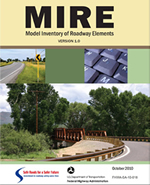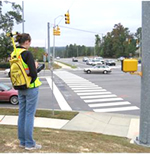U.S. Department of Transportation
Federal Highway Administration
1200 New Jersey Avenue, SE
Washington, DC 20590
202-366-4000
The FHWA Office of Safety established the Roadway Safety Data Program (RSDP) to advance State and local safety data systems and safety data analyses. Integrating quality roadway and traffic data with crash data helps agencies make better decisions and more effective use of limited funds to improve safety and meet Federal legislative requirements.


The RSDP is contributing to the evolution of more robust roadway safety data systems and advancing data-driven safety analysis capabilities through several programs including the Model Inventory of Roadway Elements (MIRE). MIRE is a listing and data dictionary of recommended roadway and traffic data elements to support safety. This program provides tools and reports to help effectively collect, integrate/manage, and measure roadway data for improved data-driven safety decision-making.
Existing and emerging collection methodologies to help guide data collection programs are documented in the MIRE Collection Mechanisms and Gap Analysis report and Exploration of the Application of Collective Information to Transportation Data for Safety White Paper. Agencies can use these reports to determine the most appropriate collection methodologies for their data needs.
Methodologies and lessons learned from MIRE data collection pilot programs in New Hampshire and Washington demonstrated the feasibility of collecting MIRE data elements within a reasonable budget and schedule. These efforts helped to identify:
This effort is documented in the MIRE MIS Lead Agency Data Collection report, which agencies can use to help guide their roadway data collection efforts.Additionally, the MIRE Data Collection Guidebook provides State and local agencies practical means to collect MIRE data that is not traditionally collected. Agencies can incorporate the recommendations from the Guidebook into their current data collection methods.
Integrating and managing additional data can be a challenge. One potential approach to integrating and managing existing and newly collected MIRE data is a MIRE Management Information System (MIS). It has been demonstrated that this can be accomplished with resources that are readily available to most agencies. The steps taken, resources used, obstacles and lessons learned are available in the Development of a Structure for a MIRE Management Information System report.
Performance measures are tools data managers can use to measure data quality and establish goals for data improvement. The Performance Measures for Roadway Inventory Data report provides data managers and collectors with refined techniques for assessing and improving the quality of roadway and traffic data inventories.
Several products and reports are now available to help practitioners improve their ability to collect, integrate/manage, and measure the quality of their roadway data to support a data-driven safety program. These include:
Visit http://safety.fhwa.dot.gov/rsdp
| Robert Pollack Federal Highway Administration Office of Safety Programs robert.pollack@dot.gov |
Carol Tan, PhD Federal Highway Administration Office of Safety Research and Development carol.tan@dot.gov |
FHWA-SA-13-021
